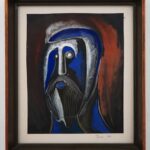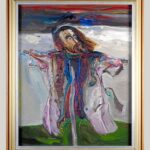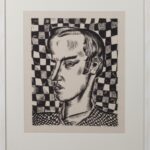
Šimulynas Šarūnas
Šarūnas Šimulynas (September 18, 1939 in Veliuona – February 2, 1999 in Vilnius) – Lithuanian sculptor, painter, poet, prose writer. In 1965, the artist graduated from the Institute of Arts with a degree in graphics, and a year later – in 1966 – became a member of the Lithuanian Artists’ Union. He belonged to the graphics, monumental art, and sculpture sections. He created frescoes, stained glass windows, decorative reliefs, sculptures in interiors and open spaces. He created many paintings.
He was admitted to the official halls of the Lithuanian SSR in 1981. Since then, he has actively participated in all events. The opportunity to organize a personal exhibition at the Exhibition Hall (now the Center for Contemporary Art) was given only in 1981. After the collapse of the Soviet Union, the doors of galleries opened wider for the artist. Since 1989, thirteen personal exhibitions of the artist have been held.
Starting with the first print exhibition, which took place in 1961, exhibitions of his paintings, drawings and sculptures have been held in Vilnius, Riga, Kaunas, Sydney (Australia), Tel Aviv (Israel). After his death, six more personal exhibitions of the author were held at the invitation of galleries in Riga, St. Petersburg and Vilnius.
The artist participated in group exhibitions in Vilnius, New York (USA), Marburg (Germany), Moscow (Russia), Warsaw (Poland), Krakow (Poland), Liberec and Brno (Czech Republic), Budapest (Hungary). Invitations to group exhibitions began only when the foundations of the Soviet system began to waver.
In 1986, “Vaga” published the artist’s book of poems “Mother of Glaciers”. In 1998, the Writers’ Union published his first book of short stories “Fatherland”, and in 1999, after the author’s death, his second book of short stories “In the Rye Under the Apple Tree” was published, awarded the P. Cvirka Prize for the best book of short stories on a rural theme.
In 1995, Šarūnas Šimulynas was awarded a scholarship from the Soros Center for Contemporary Art, and in 1996-1997 – a scholarship from the Pollock-Krasner Foundation (USA).
In 2007, the collection of Vilnius’s strongest sculptors “Vilnius. Small Plastics2” was formed. Š. Šimulynas’ works are also included in it and travel through Europe presenting Lithuanian small sculpture. In 2007, this collection visited Riga (twice), Warsaw and Budapest.
Šarūnas Šimulynas’ paintings and sculptures are in the Lithuanian Art Museum (16 works), private collections in the USA, Canada and Israel. There are three significant collections of the author’s works in private collectors in Vilnius. The artist’s works adorn indoor and outdoor spaces in public places in Vilnius, Panevėžys, Klaipėda, Alytus, Druskininkai, Veliuona.
He was buried in the Jerusalem Cemetery in Vilnius. Like his classmates P. Repšys, R. Gibavičius, R. Dichavičius, Š. Šimulynas, after graduating, did not limit his activities to the specialty indicated in his diploma. His artistic interests encompass several different areas of creativity. He painted paintings, created decorative plastic for interiors, several frescoes, and stained glass.
In 1986, “Vaga” published a book of the artist’s poems, illustrated by the author himself. However, he devoted most of his energy to sculpture. Sculptures Š. Šimulynas has created the most and most diverse (tombstones, decorative, small plastic, reliefs), in sculpture his artistic aspirations were most fully realized. In sculpture he most impressively revealed what, in his opinion, is beautiful and desirable. Having started to publicly show his sculptures, Šimulynas was met as an alien from another tradition, as a stranger. He has not created a single work on Soviet themes. From the point of view of plastic, his works were indeed significantly different from the background of Lithuanian sculpture creation at the turn of the 1960s and 1970s. He not only violated the norm of depicting a person (at that time no longer so strictly obligatory), but also violated the rule of the significance of the theme, creating volumetric forms of a refined form, the real prototypes of which did not belong to the category of socially relevant phenomena. Š. Šimulynas’s creative principles were closer not to those prevailing in sculpture at the time, but to those developed by painters and graphic artists of his generation.




